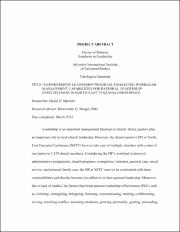| dc.description.abstract | Leadership is an important management function in church. Hence, pastors play
an important role in local church leadership. However, the district pastors (DP) at North-
East Tanzania Conference (NETC) have to take care of multiple churches with a ratio of
one pastor to 1,539 church members. Considering the DP’s workload in terms of
administrative assignments, church programs, evangelism, visitation, pastoral care, social
service, and personal family care, the DP at NETC seem to be overloaded with these
responsibilities and thereby become less effective in their pastoral leadership. Moreover,
due to lack of studies, the factors that foster pastoral leadership effectiveness (PLE) such
as visioning, strategizing, delegating, listening, communicating, training, collaborating,
serving, resolving conflict, assessing situations, growing spirituality, guiding, persuading
and organizing may not have been being observed at NETC. Hence, there is a need for an
intervention program that will enhance the DP’s workload management capabilities
(WMC) to achieve PLE.
This study addressed the overall problems of DP at NETC by proposing
empowerment leadership program. By getting the respondents’ perceptions, the study
examined (1) the extent of district pastor’s workload (DPW) in terms of administrative
assignments, church programs, evangelism, visitation, pastoral care, social service, and
personal family care; (2) the extent of DP’s effectiveness; (3) the relationship between
DPW and their PLE; (4) the significant difference in PLE when demographic profiles are
compared; (5) the significant predictors for PLE; (6) the general view of the respondents
on DPW for PLE; and (7) the proposed empowerment leadership program.
The study found out that the overall extent of DPW was perceived to be heavy
while the extent of DP’s effectiveness was perceived to be sometimes effective. Using
Pearson correlation coefficient, it was found out that there is a moderate positive
relationship between DPW and PLE. That is, there is a tendency for the DP to be less
effective at their work once DPW increases. Using multiple regressions, DPW came out
as the significant predictor for PLE. On DP’s DPW to achieve PLE, the respondents
viewed evangelism, delegating and training, fairness and equality, nature of work and the
situation of the workplace, and the DP’s growth as the main points that the NETC leaders
and the DP have to consider. Furthermore, to enhance the DP’s WMC for PLE, there was
really a need for a contextualized program. This program is designed based on the
findings of the study. Likewise, the biblical, theological, and theoretical principles were
considered as foundational structure of the program in enhancing DP’s WMC for
effectiveness of pastoral leadership at NETC. | en_US |

